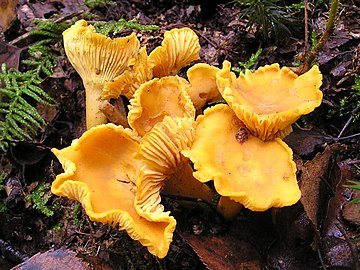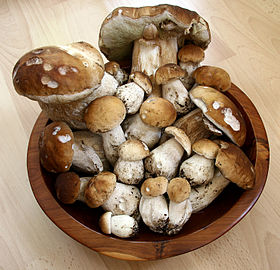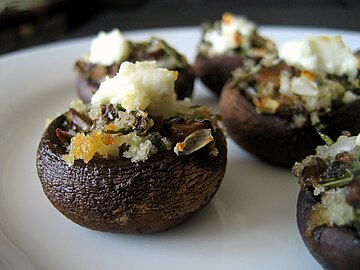Edible mushroom
This article needs additional citations for verification. (November 2018) |
Edible mushrooms are the
flavor.To ensure safety, wild mushrooms must be correctly
Several varieties of fungi contain
Edible mushrooms include many fungal species that are either
Description
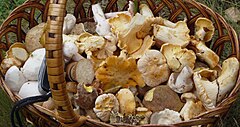
Mushrooms can appear either below ground (
List of edible mushrooms
Commercially cultivated
- Agaricus bisporus dominates the edible mushroom market in North America and Europe, in several forms. It is an edible basidiomycete mushroom native to grasslands in Europe and North America. As it ages, this mushroom turns from small, white and smooth to large and light brown. In its youngest form, it is known as the 'common mushroom', 'button mushroom', 'cultivated mushroom', and 'champignon mushroom'. Its fully mature form is known as 'portobello'. Its semi-mature form is known variously as 'cremini', 'baby-bella', 'Swiss brown' mushroom, 'Roman brown' mushroom, 'Italian brown' mushroom, or 'chestnut' mushroom.[6][7][8][9]
- Pleurotus species, the oyster mushrooms, are commonly grown at industrial scale.[9]
- Morchella species, (morel family) morels belong to the ascomycete grouping of fungi. Morels are difficult to grow commercially, but there are ongoing efforts to make cultivating morels at scale a reality.[10] Since 2014, some farmers in China have been cultivating morels outdoors in the spring; however, yields are variable.[10] Morels must be cooked before eating.
- Lentinula edodes, the Shiitake mushroom[9]
- Auricularia heimuer, wood ear mushroom
- Volvariella volvacea, the paddy straw mushroom or straw mushroom
- Volvariella bombycina
- Flammulina filiformis, the enoki mushroom, golden needle mushroom, seafood mushroom, lily mushroom, or winter mushroom
- Flammulina velutipes
- Tremella fuciformis, the snow fungus, snow ear, silver ear fungus and white jelly mushroom
- Hypsizygus tessellatus, aka Hypsizygus marmoreus, the beech mushroom, also known in its white and brown varieties as Bunapi-shimeji and Buna-shimeji, respectively
- Stropharia rugosoannulata, the wine cap mushroom, burgundy mushroom, garden giant mushroom or king stropharia
- Cyclocybe aegerita, the pioppino, velvet pioppini, poplar or black poplar mushroom
- Hericium erinaceus, the lion's mane, monkey head, bearded tooth, satyr's beard, bearded hedgehog, or pom pom mushroom.
- Phallus indusiatus, the bamboo mushrooms, bamboo pith, long net stinkhorn, crinoline stinkhorn or veiled lady mushroom.
Commercially harvested wild fungi
- Boletus edulis or edible Boletus, native to Europe, known in Italian as fungo porcino (plural 'porcini') (pig mushroom), in German as Steinpilz (stone mushroom), in Russian as Russian: Белый гриб, tr. Bely grib (white mushroom), in Albanian as (wolf mushroom), in French as the cèpe and in the UK as the penny bun. It is also known as the king bolete, and is renowned for its delicious flavor. It is sought after worldwide, and can be found in a variety of culinary dishes.
- Boletus griseus
- Boletus variipes
- Boletus pinophilus
- Calbovista subsculpta commonly known as the sculptured giant puffball is a common puffball of the Rocky Mountains and Pacific Coast ranges of western North America. The puffball is more or less round with a diameter of up to 15 cm (6 in), white becoming brownish in age, and covered with shallow pyramid-shaped plates or scales. It fruits singly or in groups along roads and in open woods at high elevations, from summer to autumn. It is considered a choice edible species while its interior flesh (the gleba) is still firm and white. As the puffball matures, its insides become dark brown and powdery from mature spores.
- Calvatia gigantea the giant puffball. Giant puffballs are considered a choice edible species and are commonly found in meadows, fields, and deciduous forests usually in late summer and autumn. It is found in temperate areas throughout the world.[11] They can reach diameters up to 150 cm (60 in) and weights of 20 kg (45 lb). The inside of mature Giant puffballs is greenish brown, whereas the interior of immature puffballs is white. The large white mushrooms are edible when young.[12][13]
- Cantharellus cibarius (the chanterelle), The yellow chanterelle is one of the best and most easily recognizable mushrooms and can be found in Asia, Europe, North America and Australia. There are poisonous mushrooms that resemble it, though these can be confidently distinguished if one is familiar with the chanterelle's identifying features.
- Craterellus tubaeformis, the tube chanterelle, yellow foot chanterelle or yellow-leg
- Clitocybe nuda, blewit (or blewitt)
- Cortinarius caperatus, the Gypsy mushroom
- Craterellus cornucopioides, Trompette de la mort (trumpet of death) or horn of plenty
- Grifola frondosa, known in Japan as maitake (also "hen of the woods" or "sheep's head"), a large, hearty mushroom commonly found on or near stumps and bases of oak trees, and believed to have Macrolepiota procera properties.
- tooth fungus; also called "lion's mane mushroom"
- Hydnum repandum, sweet tooth fungus, hedgehog mushroom or hedgehog fungus, urchin of the woods
- Lactarius deliciosus, saffron milk cap, consumed around the world and prized in Russia
- Morchella species, (morel family) morels belong to the ascomycete grouping of fungi. They are usually found in open scrub, woodland or open ground in late spring. When collecting this fungus, care must be taken to distinguish it from the poisonous false morels, including Gyromitra esculenta. The morel must be cooked before eating.
- Morchella conica var. deliciosa
- Morchella esculenta var. rotunda
- Morchella crassipes
- Morchella elata[14]
- Pleurotus species are sometimes commercially harvested despite the ease of cultivation.
- Pleurotus ostreatus
- Termitomyces species are symbiotes of termites and the mushrooms grow out of termite mounds. This genus includes the largest edible mushroom, Termitomyces titanicus, with a cap that averages 1 m in diameter,[15] though most species are much smaller. Research is underway to determine how to cultivate these mushrooms.[16]
- Tricholoma matsutake, the matsutake, a mushroom highly prized in Japanese cuisine.
- Tuber, species, (the truffle), Truffles have long eluded the modern techniques of domestication known as trufficulture. Although the field of trufficulture has greatly expanded since its inception in 1808, several species still remain uncultivated. Domesticated truffles include:
- Tuber aestivum, black summer truffle
- Tuber borchii
- Tuber brumale
- Tuber indicum, Chinese black truffle
- Tuber macrosporum, smooth black truffle
- Tuber mesentericum, the Bagnoli truffle[17]
-
Chanterelles in the wild
-
Common white mushrooms cooking (raw at lower left)
-
Baskets of mixed culinary mushrooms at the San Francisco Ferry Building
-
Calvatia gigantea, the giant puffball at a market in England
-
Boletus edulis at various ages
-
Hericium coralloides
-
Black Périgord truffle, cut in half
Other edible wild species
- Agaricus arvensis (Horse Mushroom)
- Agaricus silvaticus (Pinewood Mushroom)
- Agaricus campestris (Field Mushroom)
- Aleuria aurantia (Orange Peel Fungus)
- Amanita caesarea (Caesar's Mushroom)
- Armillaria mellea (Honey mushroom)
- Boletus badius(Bay Bolete)
- Calocybe gambosa (St George's mushroom)
- Calvatia utriformis(Lycoperdon caelatum)
- Calvatia cyathiformis
- Chroogomphus species (pine-spikes or spike-caps)
- Clavariaceae species (coral fungus family)
- Clavulinaceae species (coral fungus family)
- Coprinus comatus, the Shaggy mane, Shaggy Inkcap or Lawyer's Wig. Must be cooked as soon as possible after harvesting or the caps will first turn dark and unappetizing, then deliquesce and turn to ink. Not found in markets for this reason.
- Corn smut economically important pathogens of cereals. Known in Mexico as huitlacoche, where it is considered a delicacy. Corn smuts can be used as fillings in quesadillas, tacos and soups.[18]
- Cyttaria espinosae
- Fistulina hepatica (beefsteak polypore or the ox tongue)
- Flammulina velutipes (Velvet Shank or Winter Fungus)
- Hygrophorus chrysodon
- Kalaharituber pfeilii

- Lactarius deterrimus (Orange Milkcap)
- Lactarius salmonicolor
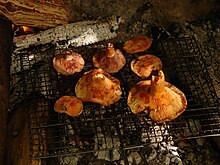
- Lactarius subdulcis (mild milkcap)
- Lactarius volemus(Fishy Milkcap). Also known as "Weeping Milkcap".
- mushroom hunters.
- Leccinum aurantiacum (Red-capped scaber stalk)
- Leccinum scabrum (Birch bolete)
- Leccinum versipelle (Orange Birch Bolete / Boletus testaceoscaber)
- Macrolepiota procera (Parasol Mushroom); globally, it is widespread in temperate regions
- Marasmius oreades (Fairy Ring Champignon)
- Polyporus mylittae
- Polyporus squamosus(Dryad's saddle and Pheasant's back mushroom)
- Pseudohydnum gelatinosum (toothed jelly fungus)
- Ramariaceaespecies (coral fungus family)
- Rhizopogon luteolus
- Russula, some members of this genus, such as R. laeta, are edible
- Sparassis crispa, also known as "cauliflower mushroom"
- Suillus bovinus
- Suillus granulatus (Weeping Bolete). Also known as "Granulated Bolete".
- Suillus luteus (Slippery Jack)
- Suillus tomentosus (Woolly-capped suillus)
- Suillus brevipes
- Suillus pictus
- Suillus decipiens
- Tricholoma terreum (Grey Knight)
Conditionally edible species
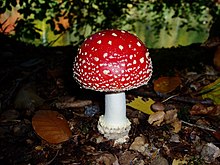
- Amanita fulva (Tawny Grisette) must be cooked before eating.
- parboiled to leach out toxins,[19] fresh mushrooms cause vomiting, twitching, drowsiness, and hallucinations due to the presence of muscimol. Although present in A. muscaria, ibotenic acidis not in high enough concentration to produce any physical or psychological effects unless massive amounts are ingested.
- Amanita rubescens(The Blusher) must be cooked before eating.
- Coprinopsis atramentaria (Coprinus atramentarius - Common Inkcap) is edible without special preparation, however, consumption with alcohol is toxic due to the presence of coprine. Some other Coprinus spp. share this property.
- Gyromitra esculenta (False Morel - Turban, Brain Mushroom) is eaten by some after it has been parboiled, however, many mycologists do not recommend it. Raw Gyromitra are toxic due to the presence of gyromitrin, and it is not known whether all of the toxin can be removed by parboiling.
- Lactarius spp. that are considered toxic elsewhere in the world are eaten in some Eastern European countries and Russia after pickling or parboiling.[20]
- Lactarius indigo
- Lactarius paradoxus
- Lactarius corrugis
- Lactarius volemus
- Lactarius hygrophoroides
- Lepista saeva(Field Blewit, Blue Leg, or Tricholoma personatum) must be cooked before eating.
- Morchella esculenta (Morel) must be cooked before eating.[21]
- Verpa bohemica is considered choice by some—it even can be found for sale as a "morel"—but cases of toxicity have been reported. Verpas appear to contain monomethylhydrazine[22] and similar precautions apply to them as Gyromitra species.
Cultivation
Some mushrooms, particularly
In 2019, world production of commercial mushrooms and recorded truffle collection reported to the Food and Agriculture Organization was 11.9 million tonnes, led by China with 75% of the total:
| Mushroom and truffle production – 2019 | |
|---|---|
| Country | (millions of tonnes) |
| 8.94 | |
| 0.47 | |
| 0.38 | |
| 0.36 | |
| 0.30 | |
| World | 11.90 |
| Source: FAOSTAT of the United Nations[24]
| |
Safety concerns
Some wild species are toxic, or at least indigestible, when raw.[25] Failure to identify poisonous mushrooms and confusing them with edible ones has resulted in death.[25][26][27] Although in the 21st century primitive digital applications exist to aid with identification (some bolstered by artificial intelligence), these are unreliable and some inexperienced hunters relying upon them have been seriously poisoned.[28]
Deadly poisonous mushrooms that are frequently confused with edible mushrooms and responsible for many fatal poisonings include several species of the genus
Additionally, several varieties of fungi are known and documented to contain
Nutrition
| Nutritional value per 100 g (3.5 oz) | |
|---|---|
| Energy | 117 kJ (28 kcal) |
5.3 g | |
0.5 g | |
2.2 g | |
Niacin (B3) | 28% 4.5 mg |
| Pantothenic acid (B5) | 44% 2.2 mg |
| Vitamin B6 | 6% 0.1 mg |
| Folate (B9) | 5% 18 μg |
| Vitamin B12 | 0% 0 μg |
| Choline | 4% 19.9 mg |
| Vitamin D | 3% 21 IU |
| Vitamin E | 0% 0 mg |
| Vitamin K | 0% 0 μg |
Copper | 56% 0.5 mg |
| Iron | 9% 1.7 mg |
| Magnesium | 3% 12 mg |
| Manganese | 4% 0.1 mg |
| Phosphorus | 7% 87 mg |
| Potassium | 12% 356 mg |
| Selenium | 24% 13.4 μg |
| Zinc | 8% 0.9 mg |
| Other constituents | Quantity |
| Water | 91.1 g |
| †Percentages estimated using US recommendations for adults,[30] except for potassium, which is estimated based on expert recommendation from the National Academies.[31] | |
Higher mushroom consumption has been associated with lower risk of breast cancer.[32] As of 2021[update], mushroom consumption has not been shown to conclusively affect risk factors for cardiovascular diseases.[33]
A commonly eaten mushroom is the
The content of
Vitamin D
| Name | Chemical composition | Structure |
|---|---|---|
| Vitamin D1 | ergocalciferol with lumisterol, 1:1[36] | |
| Vitamin D2 | ergocalciferol (made from ergosterol) | 
|
| Vitamin D3 | cholecalciferol (made from 7-Dehydrocholesterol in the skin). | 
|
When exposed to UV light before or after harvest, mushrooms convert their large concentrations of ergosterol into vitamin D2.[34][35] This is similar to the reaction in humans, where vitamin D3 is synthesized after exposure to sunlight.
Testing showed an hour of UV light exposure before harvesting made a serving of mushrooms contain twice the
The form of vitamin D found in UV-irradiated mushrooms is ergocalciferol, or vitamin D2. This is not the same as cholecalciferol, called vitamin D3, which is produced by UV-irradiation of human or animal skin, fur, and feathers. Although vitamin D2 has vitamin-D activity in humans, and is widely used in food fortification and nutritional supplements, vitamin D3 is more commonly used in dairy and cereal products.
Uses
Edible mushrooms include many fungal species that are either
Before assuming that any wild mushroom is edible, it should be correctly identified. Accurate determination of and proper identification of a species is the only safe way to ensure edibility, and the only safeguard against possible poisoning. Some edible species cannot be identified without the use of advanced techniques such as chemistry or microscopy.
History
Mycophagy /maɪˈkɒfədʒi/, the act of consuming mushrooms, dates back to ancient times. Edible mushroom species have been found in association with 13,000-year-old archaeological sites in Chile. Ötzi, the mummy of a man who lived between 3400 and 3100 BCE in Europe, was found with two types of mushroom. The Chinese value mushrooms for their supposed medicinal properties as well as for food. Ancient Romans and Greeks, particularly the upper classes, used mushrooms for culinary purposes. Food tasters were employed by Roman emperors to ensure that mushrooms were safe to eat.[37] The Forme of Cury, a 14th-century compilation of medieval English recipes, features a recipe of mushrooms and leeks cooked in broth.[38]
Culinary
Cooking
Mushrooms may be cooked before consumption to improve texture and lower trace levels of toxic hydrazines. Frying, roasting, baking, and microwaving are all used to prepare mushrooms. Cooking lowers the amount of water present in the food. Mushrooms do not go mushy with long term cooking because the chitin that gives most of the structure to a mushroom does not break down until 380 °C (716 °F) which is not reached in any normal cooking.[39][40]
Storage
Mushrooms will usually last a few days, longer if refrigerated. Mushrooms can be frozen, but are best cooked first. They can also be
-
A collection of dried mushrooms
-
Stuffed mushrooms prepared using portabello mushrooms
In traditional medicine
Medicinal mushrooms are mushrooms or
Preliminary research on mushroom extracts has been conducted to determine if anti-
-
Chicken of the woods (Laetiporus sulphureus)
-
Common morel (Morchella esculenta)
See also
References
- ISBN 978-0-544-23611-0.
- ISBN 978-0-8493-1043-0.
- PMID 10906601.
- ISBN 978-0-231-16890-8.
- ^ Paul Adams (24 November 2015). "Put the science of umami to work for you". Popular Science, Bonnier Corporation. Retrieved 11 December 2015.
- ^ "Every Type Of Mushroom You Need To Know About". Huffingtonpost.com. 19 March 2014. Retrieved 23 October 2018.
- ^ "Common Types of Mushrooms". Realsimple.com. Archived from the original on 16 November 2018. Retrieved 23 October 2018.
- ^ "What's the Difference Between Cremini and Portobello Mushrooms?". Thekitchen.com. Retrieved 23 October 2018.
- ^ a b c "Cultivation of Oyster Mushrooms". Extension.psu.edu. Retrieved 23 October 2018.
- ^ a b Alla Katsnelson (April 26, 2022). "Cultivating Coveted Morels Year-Round and Indoors". The New York Times. Retrieved June 9, 2023.
- ^ "Calvatia gigantea (giant puffball)", Discover plants and fungi, www.kew.org, retrieved 8 August 2015
- ISBN 978-0-89815-169-5.
- ISBN 978-0-8156-0388-7.
- OCLC 10207909.
- JSTOR 4110017.
- ^ "Termitomyces: exploring the world's most mysterious mushroom". World Agroforestry | Transforming Lives and Landscapes with Trees. Retrieved 2022-08-18.
- ^ T. mesenterium was first reported in Great Britain after the wet August 2008: "New fungi species unearthed in UK". BBC News. 9 October 2008. Retrieved 9 October 2008.
- ^ Neimark, Jill (24 August 2015). "Scourge No More: Chefs Invite Corn Fungus To The Plate". NPR.org. Retrieved 2020-05-18.
- S2CID 19585416. Archived from the original(PDF) on 2012-04-15.
- ^ Arora, David. Mushrooms Demystified, 2nd ed. Ten Speed Press, 1986
- ISBN 978-92-893-2383-3.
- ^ FDA IMPORT ALERT IA2502 Archived April 9, 2007, at the Wayback Machine
- ^ John Fereira. "U.S. Mushroom Industry". Usda.mannlib.cornell.edu. Retrieved 2010-05-30.
- ^ "Production of mushrooms and truffles in 2019, Crops/Regions/World list/Production Quantity (pick lists)". UN Food and Agriculture Organization, Corporate Statistical Database (FAOSTAT). 2020. Retrieved 3 March 2021.
- ^ a b "Wild Mushroom Warning. Mushroom Poisoning: Don't Invite "The Death Angel" to Dinner". US National Capital Poison Center, Washington, DC. 2017. Retrieved 11 January 2017.
- PMID 19415588.
- ^ Osborne, Tegan (2016-02-03). "Deadly death cap mushrooms found in Canberra's inner-south as season begins early". ABC News. Retrieved 2 May 2016.
- ^ Lapienytė, Jurgita (March 25, 2024). "AI tools can lead to severe mushroom poisoning". Cybernews. Retrieved 2024-03-31.
- .
- ^ United States Food and Drug Administration (2024). "Daily Value on the Nutrition and Supplement Facts Labels". Retrieved 2024-03-28.
- )
- PMC 7258270.
- S2CID 229179866.
- ^ a b c Bowerman S (March 31, 2008). "If mushrooms see the light". Los Angeles Times.
- ^ PMID 19281276.
- PMID 22868105.
- ISBN 978-1-84537-419-8.
- ^ "The Forme of Cury". Project Gutenberg. Retrieved 17 March 2024.
- PMC 4493705.
- ^ "Why you can't really overcook mushrooms". www.pbs.org. 2022-07-20. Retrieved 2024-01-26.
- S2CID 29723996.
- ISBN 978-1-884360-01-5.
- ^ "Reishi mushroom". MedlinePlus, US National Library of Medicine. 19 January 2019. Retrieved 24 January 2019.
- PMID 27020147.
- ^ "Coriolus versicolor". About Herbs, Botanicals & Other Products. Memorial Sloan-Kettering Cancer Center. 3 October 2018. Retrieved 24 January 2019.
- ^ "Lentinan (Shiitake)". Memorial Sloan Kettering Cancer Center, New York. 2017. Retrieved 11 January 2017.
- S2CID 29723996.
- S2CID 5643894.
External links
- . . 1914.
- "Pacific Northwest Seasonal Chart for Edible Mushrooms". Central Oregon Mushroom Club.

